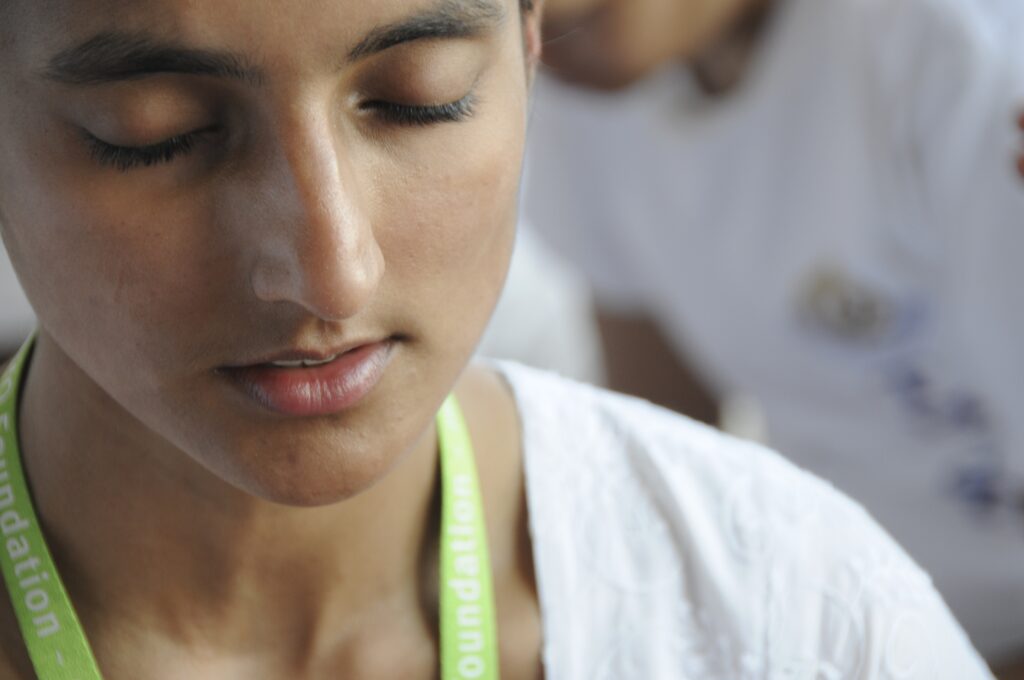The Bandhas (Body Locks)

The bandhas are the locks applied to body areas that direct the prana and apana. The locks are the basic techniques that accumulate the effects of the efforts of the practitioner. These techniques consolidate the effects of a Kundalini Yoga practice and direct prana within the physical and energetic pathways to promote healing, energizing, and strengthening of the whole human being.
The Sanskrit word bandha means to hold, tighten, or lock. This describes the precise physical action involved in bandha practice. The bandhas aim to redirect the neurobiological energies of the body into the central channel of the spine for the purpose of spiritual awakening.
“Bandhas protect and project, that is what they are for. They protect the alignment of your spine and project your energy where you want it to go.” – Guru Prem Singh Khalsa
The Four Main Body Locks
Neck Lock (Jalandhar Bandh)
What: Neck Lock is the most basic and most generally applied lock. It regulates gross and subtle movement in the upper part of the body.
How: Lift the chest and sternum up while lengthening the back of the neck, by pulling the chin toward the back of the neck. Neck, throat and face muscles remain relaxed.
When: All chanting meditation, most pranayama. Breath held in or out.
Why: Concentrates the secretions of the glandular system, thereby increasing their interconnection. Regulates blood pressure. Minimizes external distractions. Seals energy in the brain stem and moon center (chin). Directs pranic energy into the central channel, calming the heart.
Root Lock (MulBandh)
What: Root Lock is like a hydraulic lock at the base of the spine. It coordinates, stimulates, and balances the energies involved with the rectum, sex organs, and navel point (i.e. the lower three chakras).
How: Three actions are applied together in a smooth, rapid, flowing motion. First, contract and hold the muscles around the anus. Then contract and hold the muscles around the sex organ (like stopping the flow of urine). Finally, contract the muscles of the lower abdomen and the navel point toward the spine.
When: Frequently applied at the end of an exercise. Sometimes applied – continuously or rhythmically – throughout a meditation or exercise. Breath held in or out. Women on their moon cycle should not apply Root Lock.
Why: Crystallizes the effect of an exercise. Blends prana and apana at the navel center which, when mixed, opens the entrance to the sushmuna for energy to flow up the spine. Stimulates the proper flow of spinal fluid.
Diaphragm Lock (Uddiyana Bandh)
What: Diaphragm Lock vertically integrates emotions, pranic energy, and functions that occur above and below the diaphragm muscle. Tightness in this muscle – and the emotions it stores – can make this lock more difficult to achieve.
How: Inhale, then exhale completely. Pull the entire abdominal region up and back towards the spine. The navel point is not contracted although it will move upwards. Lift the chest while gently pressing the lower spine forward. When held properly, the “notch” at the base of the front of the throat becomes accentuated. Hold for 10 to 60 seconds without straining. Then relax the abdomen, gradually inhaling without releasing the Neck Lock or raising the chin.
For many people it is easier to practice this lock in a standing position. With the feet shoulder width apart, bend forward slightly, hands on knees and back straight. Lifting the chest slightly, apply the lock.
When: On an empty stomach. Held after breath fully exhaled.
Why: Massages intestines and heart muscle. Stimulates cleansing, promotes youthfulness. Strengthens the fire element, Third Chakra, and opens the Heart Chakra, resulting in increased kindness, compassion, and patience.
Great Lock (MahaBandh)
What: The Great Lock is part of the central infrastructure of Kundalini Yoga.
How: With the breath held out, apply all three locks (Neck, Diaphragm, and Root) simultaneously.
When: On an empty stomach. Held after breath fully exhaled. Done in various postures and with different mudras.
Why: Rejuvenates glands, nerves, and chakras. It is said to cure many ailments such as improper blood pressure, menstrual cramps, intestinal irregularity, and more.
Yogi Bhajan on the Locks
It is a fundamental law of most exercises in Kundalini Yoga that you will apply Mulbandh, though it is not asked for in detail in all instances. You will be told to put yourself in a posture with a certain sound current and a certain breathing pattern. But all the kriyas have certain things in common which are assumed. First, is the proper posture and second, the locks. You are required to apply these three locks properly and appropriately. Then one is said to be in the state of mahabandh—the Great Lock. This yoga was designed carefully by saints and masters and is the fastest route to elevation and happiness.
[From Divine Alignment by GuruPrem Singh, and The Aquarian Teacher: KRI Teacher Training Textbook Level One]
Your experience is important!
Share your wisdom with others like you. Leave your comment below

Meditation for a Calm Heart - 3HO International
[…] in an Easy Pose, with a light jalandhar bandh. Place the left hand on the center of the chest at the Heart Center. The palm is flat against the […]
Neck Lock (Jalandhar Bandh) - 3HO International
[…] View Other Body Locks (Bandhs) […]